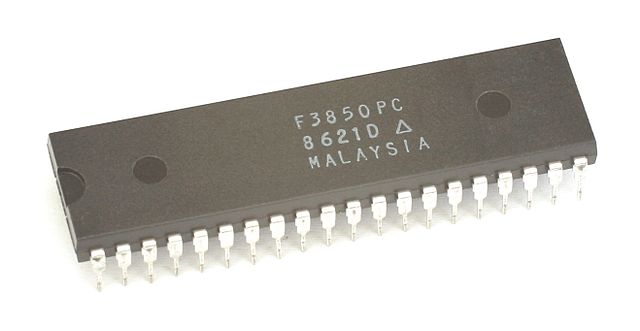The Fairchild F8 is an 8-bit microprocessor system from Fairchild Semiconductor, announced in 1974 and shipped in 1975. The original processor family included four main 40-pin integrated circuits (ICs); the 3850 CPU which was the arithmetic logic unit, the 3851 Program Storage Unit (PSU) which contained 1 KB of program ROM and handled instruction decoding, and the optional 3852 Dynamic Memory Interface (DMI) or 3853 Static Memory Interface (SMI) to control additional RAM or ROM holding the user programs or data. The 3854 DMA was another optional system that added direct memory access into the RAM controlled by the 3852.
F3850, the CPU of the Fairchild F8 system.
The Fairchild F8 microcomputer was made available in late 1975 to electronic design engineers. The board has three large scale integration devices packaged in 40-pin ICs: CPU, PSU, and SMI. This circuit board performed as a 1 KB 8-bit personal computer which interfaced to a Teletype. The design permitted additional interfaces to floppy disk and other devices. A program called Fairbug, which resided in a 1K PSU, allowed users to view and change memory and registers, and test programs written in the machine code. This device appeared at the beginning of the transition from time shared computers to personal computers.
Fairchild Semiconductor International, Inc. was an American semiconductor company based in San Jose, California. It was founded in 1957 as a division of Fairchild Camera and Instrument by the "traitorous eight" who defected from Shockley Semiconductor Laboratory. It became a pioneer in the manufacturing of transistors and of integrated circuits. Schlumberger bought the firm in 1979 and sold it to National Semiconductor in 1987; Fairchild was spun off as an independent company again in 1997. In September 2016, Fairchild was acquired by ON Semiconductor.
The building at 844 East Charleston Road, Palo Alto, California, where the first commercially practical integrated circuit was invented
The historic marker at the Fairchild building at which the traitorous eight set up shop and the first commercially practical integrated circuit was invented




